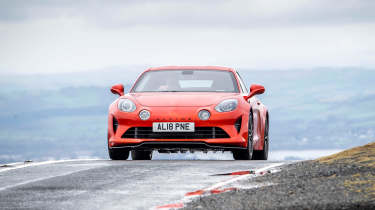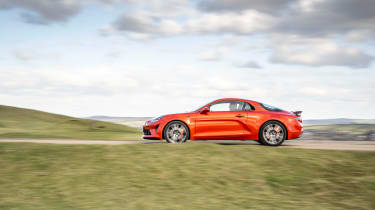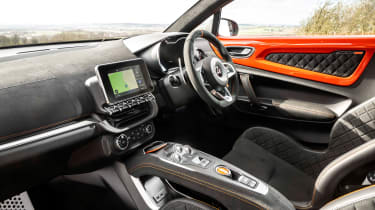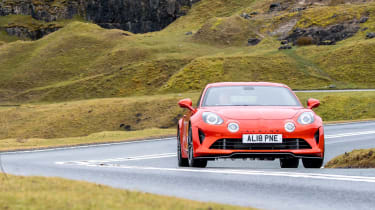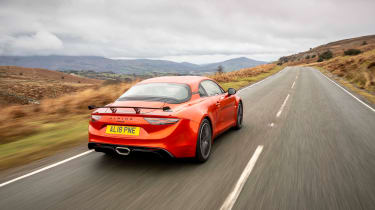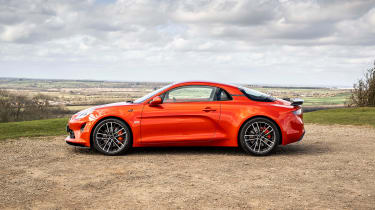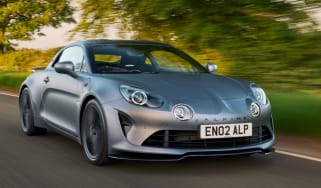Alpine A110S 2023 review – a supercar in miniature with a talent all its own
The A110 continues to impress and the high-spec S is no different. This is a fabulous little sports car
The Alpine A110 has arguably been the most important sports car of the past decade, showing that the performance car doesn’t necessarily have to be about ever-spiralling power outputs, lower lap times, rock-hard ride quality and burgeoning kerb weights.
Yet, as much as we adore it for its unique driving experience, there were aspects of the handling that we felt could be improved, such as the stability of the car in certain situations and the steering response.
The A110S was designed to be an answer to these quirks, bringing with it a higher-grade version of its turbocharged 1.8-litre engine, stiffer suspension set-up and more of an overt track-focused nature. Of course, these changes could at once fix the A110’s problems, but they might also erode the very character that makes the standard version so beguiling.
The changes to the powertrain for the S model are small, but have a notable effect. Boost pressure has been raised by 0.4 bar, and further calibration work has found an extra 47bhp, taking peak power from 249bhp to 296bhp. Torque is upped to 251lb ft, the plateau lasting from 2400rpm to 6000rpm.
The broader torque band and extra top end power mean this is a more enthusiastic engine to rev out than the standard car, and it also drops the 0-62mph time down a tenth to 4.2sec. The top speed rises slightly to 162mph (or 171mph with the Aero kit), and the kerb weight is now listed as 1114kg, but can be lowered to 1107kg if the options of a carbon roof and the forged alloy wheels are selected.
More reviews
Yes, there’s a bit more man-made suede in the cabin, a new flash of orange in the tricalore on the C-pillar and on the interior trim, and items that are optional on the Pure, such as the big brake kit and sports exhaust, are now standard on the S. But what really marks out the S are the changes to its chassis. The anti-roll bars are 100 per cent stiffer than on the standard car, and the springs 50 per cent firmer, with the dampers retuned to match. The car sits 4mm lower than the standard model, and the tyres are wider at 215 front/245 rear, and wear a specific compound Michelin Pilot Sport 4 developed for the S model.
In 2021, the S picked up a few additional elements to further distinguish it from the standard 110, including a carbon aero pack that included a subtle lip spoiler and less subtle rear wing, as well as an optional Michelin Cup 2 tyre.
Alpine is keen to stress that this doesn’t mark too big of a change in philosophy: the standard A110 we know and love continues alongside the S (and GT model that combines the base car’s softer chassis with the more potent powertrain). Here, though, we’ll focus on the S, which is aimed at those who would prefer more precision and high-speed composure, whether during fast road driving or on track.
From the very first metre travelled the A110S wraps you tightly in a warm Gallic embrace, involving you, goading you to push a bit harder, to experiment with the car’s weight balance and the cornering line. Thankfully, it’s immediately obvious that the Alpine’s ride quality has not been sacrificed in the transformation. It still seems to float magically over the top of a road, and exhibits enough body movement to keep you so well signposted as to its immediate intentions.
What’s different is how the driver feels that much more connected to the car: the steering has more weight and more precision around the straight-ahead, and when the car turns, the reduction in body roll boosts confidence that the little nose is going to head exactly where you point it. High-speed direction changes are now much calmer moments, but there’s still the sense that the Alpine’s grip on the road is a deft one, allowing you to adjust its trajectory with the throttle or into the corner with the brake pedal.
The harder you drive the A110S, the more it seems to like it, and the engine plays its part, too, spinning with much more enthusiasm to the red line. It always feels more than quick enough, and while the ’box lacks the immediacy and punchy shifts of Porsche’s PDK, it does enough not to be a hindrance in the overall package.
On its optional Cup 2 rubber, it has astounding purchase on the road surface, locking itself down with superb grip at both ends. This does raise the limits, and therefore pushes the chassis to a higher limit, but it’s never snatchy and feels far more confident at high speeds.
Yet as excellent as the A110S is, we can’t help but concede that some of the base car’s ultimate feedback has been eroded, making the S feel somewhat more generic to drive. At £61,990 it’s also exactly £10,000 more expensive than the base car, and somehow starts to feel like a slightly more challenging value proposition.
Price and rivals
The competition is fierce in this class and at this price point. Porsche’s 718 Cayman most closely aligns as a 345bhp S model, which when specified with the PDK transmission and Sport Chrono Package matches the Alpine’s 4.2sec 0-62mph time and costs £61,274 so specced. Its 1385kg kerb weight negates any power and torque advantage it may have, but comes with a more complete, albeit familiar driving experience. Specify an A110 S with a carbon pack and a few extra goodies including the Fire Orange paint and you’ll be knocking on the door to the price of a Cayman GTS 4.0.
There’s also the Toyota Supra 2.0 Pro priced from £50,485. It’s less focused and has a few quirks to its chassis and handling balance, but over time is a real grower, and makes for an excellent and more balanced grand tourer. The Supra 3.0 is now available with a six-speed manual and comes in at £54,485, and despite still having a few flaws in the chassis department, is quite the little hot-rod, feeling like something of a bargain considering its price. Toyota's brilliant GR86 drives even better, and comes with a staggeringly reasonable £29,995, but we'll contain our excitement for it as very few will make it to the UK and all are already sold (for the entire 3 year run!).
They’re all cars with tremendous appeal, but each also has significant flaws, and none can offer the sublime driving experience of the A110S. The only issue with the S is perhaps the GT, which has found somewhat of a sweet spot in a very talented little range.

